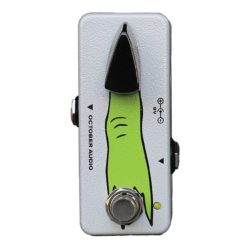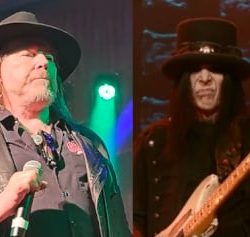
October Audio NVMBR Gain Review
Usually when I get the finger, it‘s nowhere near as much fun as October Audio’s NVMBR Gain. With just one dial and a graphic of a witch’s severed digit on top, the NVMBR Gain does a lotSnap it on with the knob all the way left, and it works as a 5 dB line boost—good to keep your amp or downstream effects sounding louder but clear. Turn it toward noon, and the output slowly increases. The company says the left side of the dial is a clean boost, but to my ears there’s subtle compression and a mid-forward attitude that TS fans should dig as much as I did. At 12 o’clock—where the pedal’s character really starts to change—I got hair and airy sparkle that, with my PRS SE Silver Sky’s single-coils, sounded like Hughie Thomasson’s opening riffs in the Outlaws classic “Green Grass and High Tides.”The right side is this little monster’s other, nastier head. From noon to floored, it unleashes a soft-clipping-style overdrive that goes from perfect for gritty controlled blues to gnashing. If Syd’s “Interstellar Overdrive” tone is your thing, all the way right is where you’ll find it. But after, say, 3 o’clock the clipping accelerates exponentially, so abandon hope of much subtlety if you venture there. I could easily see this mere 3.63″ x 1.5″ x 1.88″ stomp replacing another drive or two, to free up pedalboard space. And at $109, it offers a lot of functionality at a bargain tag.
Read more »
Polaris announce European tour
POLARIS have announced a headlining European tour! Set for March next year, the tour will see the Australian metalcore band touring across mainland Europe and the UK in support of their…
Read more »Moon Tooth release new song ‘Grimothy’
MOON TOOTH have released a brand new song! The new song, titled Grimothy, is the brand new single from the Long Island-based band and marks their first new music since their last…
Read more »
Stompboxtober 2023 Day #14 – ISP Technologies
Day #14 is here! Enter for your chance to win an ISP Technologies Deci-Mate G Micro Decimator!Stompboxtober 2023 Day 14 – ISP Technologies
ISP Technologies DECI-MATE G Micro Noise Reduction Pedal with Loop Connections
ISP Technologies introduces the new DECI-MATE G™ Micro Decimator pedal. The DECI-MATE G pedal is a full implementation of the world renowned Decimator G circuit with new patent pending tracking improvements all in a small, micro pedal package. When real estate is critical the DECI-MATE G is the answer. Now you can have the best noise reduction available in a micro pedal package with the full functionality of the larger G version of the Decimator pedal. The DECI-MATE G has a loop to insert your noisy pedals or connect to the effects loop of a guitar amplifier that has a series loop. The G version of the Decimator allows the noise reduction to directly track the guitar output. The advantage of tracking the direct guitar is the noise floor of the direct guitar output remains constant when you switch pedals or preamplifiers with different gain settings. This allows the DECI-MATE G to eliminate the noise in your rig without any need to adjustment it’s threshold setting for different gains and the corresponding noise floor changes. You can switch between extreme high gain and clean and never need to adjust the threshold. The ISP Technologies engineering team has spent years perfecting the operation of real time noise reduction and has been awarded multiple patents for the Decimator Technology. Patents include the technology for the adaptive response of the Decimator, which tracks the envelope of both super fast staccato notes as well as long sustained notes.
Read more »
DON DOKKEN: ‘MICK MARS Wrote A Ton Of MÖTLEY CRÜE Songs’
In a new interview with Artists On Record Starring ADIKA Live!, DOKKEN frontman Don Dokken weighed in on MÖTLEY CRÜE guitarist Mick Mars’s decision to no longer tour with the legendary rock act because of his long struggles with degenerative disease ankylosing spondylitis. Ankylosing spondylitis is…
Read more »
Taste Meets Technique: A Larry Carlton Primer
Let’s play a quick game of “Jeopardy.” The category: Guitarists with Wildly-Successful 50-year Careers. The answer: With over 3,000 sessions under his belt, this guitarist has been a first-call session player, recording with artists such as Steely Dan, Michael Jackson, and Dolly Parton, is also a successful solo artist, having released 36 albums, and a four-time Grammy Award winner. The question:Who is Larry Carlton?Perhaps unknowingly, we have all heard Carlton’s signature, lyrical guitar style more times than we can imagine, on a countless number of classic records, movie soundtracks, and TV themes. Just check out his impeccable touch and tone on Mike Post’s theme from TV’s “Hill Street Blues,” for which Carlton won the 1981 Grammy for Best Instrumental Performance.Now, let’s break down his style with an exploration of some of his classic work with Steely Dan and over his solo career.It Begins with the BluesCarlton earned the nickname “Mr. 335” for his almost exclusive use of a Gibson ES-335 model during much of his early career. Known for his “sweet” sound, he seamlessly married the soul of blues, the spirit of rock, and the sophistication of jazz. The foundation for his playing, though, is decidedly the blues, and one of his early idols was blues master B.B. King. Traditional blues is a style with a somewhat purposefully limited vocabulary, most of which is drawn from the six-note blues scale (1–b3–4–b5–5–b7). All this means is that it’s the player’s style which must take center stage.Carlton’s playing is brimming with personality, which he expresses in tastefully subtle ways. Ex. 1 emulates his distinct touch in songs such as “Blues Bird” from his classic 1982 solo album Sleepwalk.It’s the nuances of Carlton’s playing with stand out here, as it’s more about how he plays the notes than the notes themselves. Notice how the slowness of measure 1’s initial bend and the overbend on beat 4 of measure 2 both pack a hefty punch. The vibrato for the Eb at the end of measure 2 doesn’t begin until after the note is held for a bit, allowing it to just hang in the air for a moment. Then in measure 3, the dot over the “and” of beat 3 indicates the note should be played staccato, or short. Similarly, the accents in measure 4 indicate to play those particular notes a bit louder.It’s fun to note that a classic Carlton technique is the way he often chooses to pick notes on the higher strings exclusively using upstrokes. However, instead of using the usual flat part of the pick, the key here is to scratch the strings with its narrow inside edge, which lends a gnarly grit, as you can hear in Ex. 2.These Ghosts Aren’t ScaryTo capture Carlton’s style, we’re going to need to dip our toes ever so slightly into the pool that is jazz guitar. Don’t worry, though, you don’t have to be able to improvise over saxophone colossus John Coltrane’s “Giant Steps” to avail yourself of some of the style’s finesse and flavor.Let’s look a key nuance of jazz phrasing that contributes to the character of Carlton’s playing—ghost notes. These notes are almost not played, sounded just enough to give a phrase a certain “bounce” that is so common in jazz. Steely Dan’s 1976 release The Royal Scam, was a coming-out party of sorts for Carlton, having contributed a number of soon-to-be classic solos, most notably in “Kid Charlemagne.” Ex. 3, however, is a motif he plays throughout the album’s title track. Meant to sound implied, ghost notes are often fittingly indicated in parentheses, as shown in our example. Play each of these softer, so as to make it sound as if they’re bouncing off of the ones which surround them.Hitting All the Right NotesCarlton’s vast knowledge of jazz harmony gives him the ability to add a variety of colors to his playing which aren’t common in blues or rock guitar. He accomplishes this by touching on extensions, notes built on top of a 7th chord that “extend” the chord. For example, some common extensions of a Cmaj7 chord (C–E–G–B), are its 9 (D), #11(F#) and 13 (A). Each of these notes has a distinct color that Carlton uses as if he’s painting on a canvas.Ex. 4 is reminiscent of his playing on Miles Davis’ “So What” from his Grammy-nominated 1987 live album Last Nite. Played over a Dm11 chord, the phrase lands squarely on the 11 (G) on the first beat of measure 1, then continues with a series of descending arpeggios, touching on the 9 (E) and 13 (B). Play this phrase slowly, absorbing the unique character of each of these notes.Here’s Carlton smokin’ on an alternate live version of this classic tune:Ex. 5 is an example of how Carlton approaches using extensions in more of a rock setting. “Don’t Take Me Alive,” another song from The Royal Scam that showcases Carlton’s mastery, features this phrase in its intro solo.Now, you’ve likely played this lick many times before. But it’s how Carlton implements it here that is striking. Using rock-style string bending, he directly targets the 9 (D) and 11 (F). How does he find them? Well, here’s a quick trick: Over a minor chord, you can often play the minor pentatonic scale a fifth above. So, over the Cm7 chord in Ex.5, instead of using the standard C minor pentatonic scale (C–Eb–F–G–Bb) Carlton uses G minor pentatonic (G–Bb–C–D–F) which readily makes the 9 (D) available via a host of basic pentatonic licks you almost certainly already know. It’s a jazzy take on rock playing without sounding like you’re trying to impress your friends with some highfalutin jazz licks.Here’s yet another instance (Ex. 6) of Carlton targeting extensions, this time within a beautiful fill over a major chord in “Daddy Don’t Live in That New York City No More” from Steely Dan’s 1975 album Katy Lied.How does he do it this time? We’re in the key of E minor, with Cmaj7 functioning as the bIVm chord, and he simply draws from the E minor scale (E–F#–G–A–B–C–D). Not impressed? Take a closer look to see how Carlton views the fretboard as a palette of colors, aware of how each note in the scale functions over the chord. He subsequently targets the major 7 (B), 9 (D), and 11 (A), letting the notes ring over each other for effect.Ex. 7, our final music example, is a Carlton-style phrase that makes use of some of the key elements we’ve discussed above: targeting the 9 of the Dm9 and Fm9 chords (E and G, respectively), with the addition of some well-placed staccato, accented, and ghosted notes.Larry Carlton’s unique and soulful style most certainly developed out of his keen melodic and rhythmic sense. But it also leans heavily on the musical nuances he has consistently mined throughout his storied 50-year career. Focusing on them in your own playing can be a path to finding your own unique voice on guitar.
Read more »
Watch: K.K. DOWNING’s KK’S PRIEST Plays Final Show Of U.K. Tour In London
Former JUDAS PRIEST guitarist K.K. Downing’s new band KK’S PRIEST played the final its five-date U.K. headlining tour this past Thursday night (October 12) at O2 Shepherd’s Bush Empire in London. Fan-filmed video of the concert can be seen below.
The setlist was as follows:
01. Hellfire Thunderbolt…

(HED) P.E. Unleashes New Single ‘Too Late’ From Upcoming Album ‘Detox’
Long-running SoCal band (HED) P.E. has released a new single, “Too Late”, from the band’s upcoming album “Detox”.
Frontman Jared Gomes comments: “The new song ‘Too Late’ is about taking shit for granted and by the time you realize it’s too late. I spent more time on this record than every record bef…

ORGY Releases New Single ‘Ghost’
ORGY has released a new song called “Ghost”. The band’s second release of 2023 is a heavy hitter geared towards active rock stations. This collaboration was built from a track created by John Sustar of Star Precision Music, Ralf Dietel of KRASHKARMA, Joey Scream, Carlton Bost and Jay Gordon.
ORGY wi…

NEW YEARS DAY Shares Music Video For Latest Single ‘Vampyre’
Rock band NEW YEARS DAY invites fans to join them in the world of “Vampyre” with a brand new video game-style music video. The ferocious single — a message of strength and resilience in the face of those who would drain you of both — was released late last month, marking NEW YEARS DAY’s first new mu…
Read more »